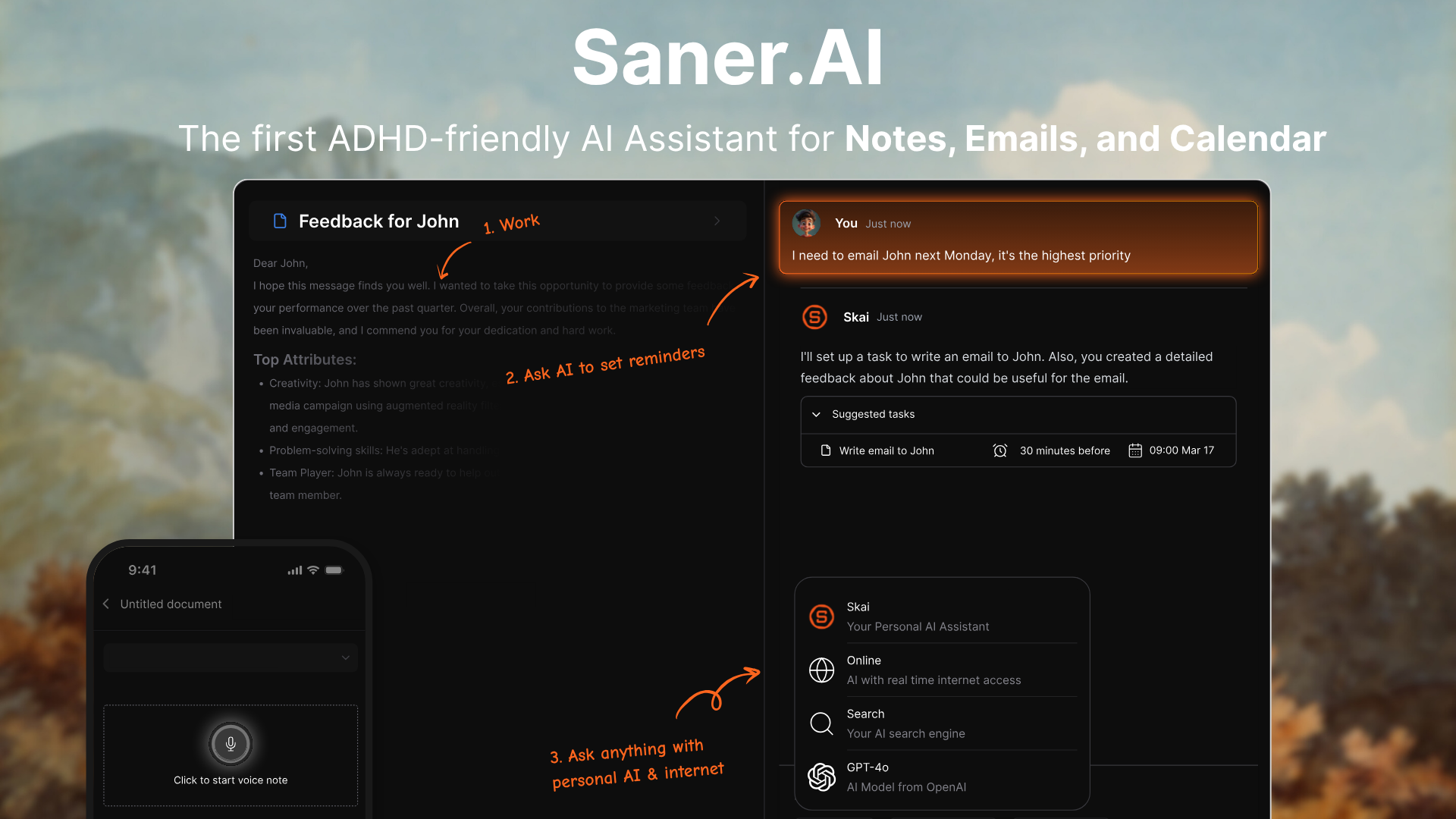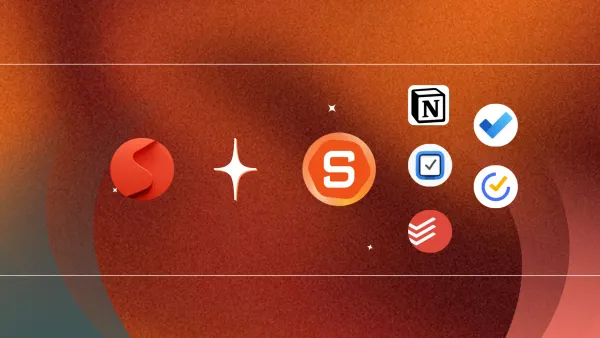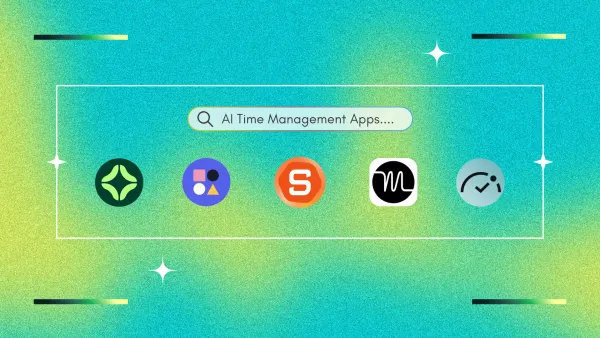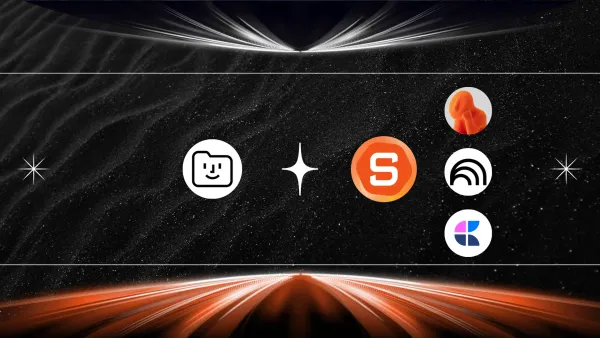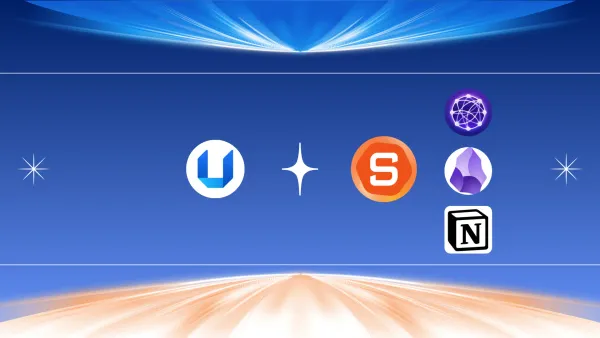Personal Purpose Statement Example and How to Create Them
Learn what a personal purpose statement is, why it matters, and how to write your own. Includes templates, examples, and expert tips.

What Is a Personal Purpose Statement? (Examples, Templates, and How to Write Yours)
In today’s fast-paced, hyperconnected world, many people are chasing productivity without pausing to ask why they’re doing what they’re doing. Burnout, career pivots, and existential drift are signs of a deeper issue: a lack of clarity about purpose.
That’s where a Personal Purpose Statement comes in. Whether you’re navigating career decisions, striving for personal growth, or leading a team, defining your purpose helps cut through the noise and align your life with what truly matters.
In this post, you'll learn:
- What a personal purpose statement is (and what it isn’t)
- Why it’s important for your life, work, and well-being
- A step-by-step guide to writing your own
- Real-world examples and fill-in-the-blank templates
- How to avoid common mistakes
- Practical ways to use your purpose statement every day
Let’s begin
What Is a Personal Purpose Statement?

A personal purpose statement is a short, powerful declaration of your core reason for being. It reflects your values, strengths, and the impact you want to make in the world.
You might hear it called:
- A life purpose
- Personal mission statement
- Guiding statement
A personal purpose statement gives you direction. It connects your daily actions to a deeper “why.”
Why It Matters
1. Clarity and Confidence
A personal purpose statement provides a lens through which to view decisions, big or small. Instead of second-guessing, you operate from a place of alignment.
2. Career and Leadership
Leaders with a clear sense of purpose inspire others. Employees with purpose are more engaged, productive, and resilient. Purpose drives performance.
3. Mental Health and Motivation
Knowing your purpose reduces stress and increases life satisfaction. It acts as an internal compass during uncertain or difficult times.
How to Write a Personal Purpose Statement
Here’s a simple, 4-step method to craft your own statement
1. Reflect on Your Values
Ask yourself:
- What principles guide my decisions?
- What matters most to me in life and work?
Use a values list or journaling prompts to clarify.
2. Identify Your Strengths
Consider:
- What are you naturally good at?
- What do others come to you for?
Strengths don’t have to be flashy - they just need to be true.
3. Define the Impact You Want to Make
Purpose lives at the intersection of your strengths and the change you want to see.
- Who do you want to serve?
- What change do you want to create?
4. Condense into 1–2 Sentences
Aim for clarity over cleverness. Use simple language that feels honest.
Templates for Personal Purpose Statement
Try these sentence starters:
- My purpose is to [verb] for [audience] so that [result].
- Example: My purpose is to simplify mental health resources for busy professionals so they can thrive.
- I help [who] by [how] because [why].
- Example: I help college students build better habits by teaching simple systems because I believe everyone deserves to succeed.
- I exist to [action] in order to [desired outcome].
- Example: I exist to create space for honest conversations in order to build more compassionate communities.
- I use my strengths in [skill or domain] to [mission].
- Example: I use my strengths in storytelling and design to empower non-profits to communicate their impact.
- To me, life is about [value] so I [related action].
- Example: To me, life is about growth, so I support others in discovering and reaching their potential.
Real-World Examples
Students: “My purpose is to explore and share knowledge so I can help others grow with me.”
Entrepreneurs: “My purpose is to create meaningful solutions that simplify people's lives.”
Creatives: “I exist to express truths that help people feel seen, heard, and understood.”
Professionals: “I help teams thrive by building trust and encouraging curiosity.”
Famous Examples
- Oprah Winfrey: “To be a teacher. And to be known for inspiring my students to be more than they thought they could be.”
- Simon Sinek: “To inspire people to do the things that inspire them so that, together, we can change our world.”
- Richard Branson: "To have fun in my journey through life and learn from my mistakes"
- Steve Jobs: "We’re here to put a dent in the universe. Otherwise, why even be here?"
How Saner.AI help you with your Personal Purpose Statements
🧠 1. Connect the Dots Across Your Notes
Most people already have clues about their purpose - hidden in journals, book highlights, meeting notes, voice memos, or personal reflections.
🧩 Saner.AI helps surface these patterns by:
- Understanding all your content holistically
- Connecting ideas across documents
- Synthesizing recurring themes (like your values, passions, and impact areas)
Example:

✍️ 2. Generate and Refine Purpose Statements with AI
Saner isn’t just a search tool. It can actively help you draft, revise, and test personal purpose statements based on your input and notes.
You can ask things like:
“Based on my values and life goals, can you help me write a personal purpose statement?”
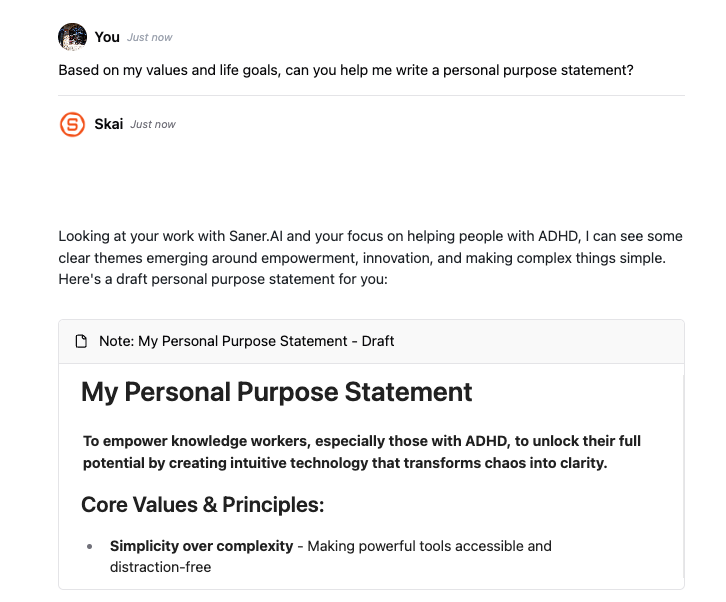
Or:
“What themes show up most across my journal entries?”
Saner can generate multiple versions so you can pick the one that feels most authentic.
🧭 3. Turn Your Purpose Into Daily Action
It’s one thing to write a personal purpose statement—it’s another to live by it.
Saner can help you:
- Reflect daily: By pulling purpose-aligned notes into your morning planning or evening journaling.
- Set aligned goals: By suggesting tasks and focus areas that match your purpose.
- Stay focused: By reducing distractions and reminding you of your core values when you drift off course.
🧩 4. Make sure you're always on track with your Purpose

You can even search your entire tasks/notes for:
- “What tasks do I have that align with my purpose?”
- “Times I felt most energized or fulfilled”
- “Moments that shaped my current values”
This action helps you check in on your tasks, priorities, and make sure they are actually aligned with your purpose
Create and Follow your Personal Purpose Statements effortlessly
FAQs About Personal Purpose Statements
1. What is a good personal purpose statement?
A good personal purpose statement is clear, specific, and authentic. It captures the essence of what drives you and the impact you want to have. It typically answers three core questions:
- What do I care deeply about?
- What am I good at?
- Who or what do I want to serve or improve?
Example: “My purpose is to help early-career professionals build confidence and clarity so they can thrive in the workplace.”
2. How long should a personal purpose statement be?
Ideally, it should be 1–2 sentences long - short enough to remember and repeat, but long enough to include your values, strengths, and intended impact. Brevity helps with clarity and makes it easier to apply in everyday life.
3. Can a personal purpose statement change over time?
Absolutely. Your purpose can evolve as you gain life experience, face new challenges, or shift your career or personal goals. Many people revisit and revise their statements every year or during major life transitions like graduation, career changes, or personal awakenings.
4. What’s the difference between a personal purpose statement, mission statement, and vision statement?
Here’s how they differ:
- Purpose Statement = Why you exist (your core motivation)
- Mission Statement = What you do (the action or work you’re committed to)
- Vision Statement = Where you’re going (the future you want to create)
5. Is a personal purpose statement only for work or career?
Not at all. While it can be powerful in a professional context, a personal purpose statement is primarily for you. It applies to how you live, make decisions, nurture relationships, and show up in the world. You can write one focused on work, one on family, or one that encompasses all aspects of life.
6. Where should I write or display my personal purpose statement?
Anywhere you'll see it regularly:
- Journal or planner
- Your AI assistant prompt
- Phone or desktop wallpaper
- LinkedIn bio or resume header
- Daily affirmations or journaling templates
Seeing it often helps you live in alignment with it.
7. How do I know if my purpose statement is right?
Ask yourself:
- Does this feel true to me - not who I wish I was, but who I am?
- Does this energize or ground me when I read it?
- Can I imagine using this as a filter for future decisions?
You can also share it with a trusted friend or mentor for feedback.
8. What if I feel lost or unsure about my purpose?
That’s completely normal. Start by reflecting on moments when you’ve felt most alive, proud, or useful. Try journaling prompts, values assessments. You might also explore purpose through therapy or coaching.
9. Should my personal purpose statement be aspirational or realistic?
It should be grounded in truth, but it can reflect a higher vision of what you’re working toward. The best statements blend your current identity with your ideal impact. Avoid exaggerating or copying language that doesn’t feel authentic.
10. Can I use my personal purpose statement in job interviews or networking?
Yes! A strong purpose statement helps you stand out and convey self-awareness. You can:
- Open your personal elevator pitch with it
- Include it in your LinkedIn “About” section
- Use it to guide your career storytelling in interviews
It shows employers and collaborators what truly drives you, beyond your resume.
Conclusion
A well-crafted personal purpose statement is more than a self-help exercise - it’s a compass for your life. It brings clarity when you're lost, courage when you’re scared, and direction when you’re drifting.
Start small. Reflect honestly. And don’t aim for perfection - just truth.

